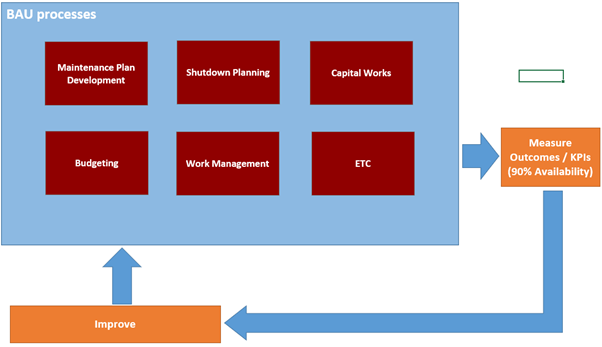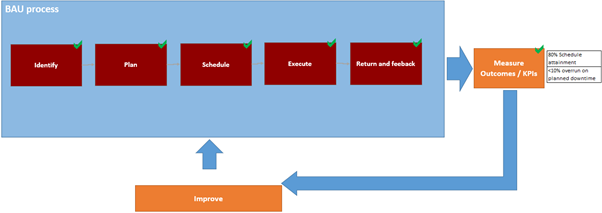Usually KPIs focus on the outcomes of our processes, but if we aim to manage processes for more predictive outcomes, we need to develop KPIs that support them.
As a consultant I am exposed to many ways that organisations perform maintenance work management functions. What seems to be fairly common is the suite of KPIs and I often wonder how much thought was put into it or was it just assumed that this is what it should be.
We are aware that as an engineering function we are striving to deliver reliable equipment that is available when required, because we have maintained it to a certain level within the constraints of available resourcing. This often leads to KPIs and targets such as 90% Availability (probably the most common) for example. Of course, we have many other metrics such as MTTR, MTBF, Budget compliance etc that normally accompany Availability. Multiple processes contribute to these KPIs (some examples below), but how do we ultimately measure or manage our individual contributions to supporting these processes or requirements?

We need to recognise that achievement of KPIs such as Availability should be a result of following the correct Business as Usual (BAU) processes rather than by accident (naturally there will be unforeseen breakdowns and outliers). We should be confident that if the processes and procedures are followed, we should achieve the desired result. If this is not the case, change is required which may be related to processes, work instruction content and frequencies, modifications etc.
One of the key contributing processes to achieving high levels of engineering Availability is the work management process as depicted in the basic example below:

The work management process supports achievement of an Availability target by ensuring we comply to schedule and that there is no overrun on planned downtime events.
If achievement of lagging indicators such as Availability is therefore only a product of doing the right thing, the best we could do for our business is to ensure that everybody is doing the right thing by following the BAU processes. Like baking a cake, if we follow the method (process) and have the correct amounts (process KPIs) of ingredients then we will ultimately end up with a cake (Outcome KPI: 90% Availability).
Defining a business process aligned KPI framework relies on having well-defined business processes that have clearly defined activities and responsibilities. These process-aligned KPIs define measurable requirements for each key step in the process. Subsequently, each KPI, because of its relationship to the business process, will have a responsibility attached to it and ultimately ownership, which supports an empowered workforce.
Let’s take a closer look at what these KPIs might represent in practice using the basic work management process as example:

Process aligned KPIs might relate to response times, data quality requirement or any handover point that can be tracked through the CMMS or relevant system. Here are some examples of KPIs that support the process steps above:

Each person or role identified in the KPI framework above now has a specific measurable responsibility that will support schedule attainment and downtime overrun% to ultimately help achievement of the greater Availability target. In practice a set of KPIs like this supports self-management of process outcomes.
Most dashboard reporting and BI tools can give a real-time (dependent on data-loads and scripting frequencies of course) and graphical view of our KPIs. Essentially showing exactly what is happening in the business process, driving the inputs and procedural compliance that deliver results.
Assuming that you are already running a CMMS with reporting capability, there are a few key elements required to support process aligned KPIs, with the most important being:
- Solid business processes with clear roles and responsibilities,
- Alignment of business process and supporting software / systems,
- Discipline in following the process (which will be aided by the KPIs themselves), and
- Quality Master Data to support reporting and BI.
In conclusion, defining a process aligned KPI framework, following the direction of the KPIs and maintaining the targeted requirement of each process activity or step means that the business process is being driven and that the right outcomes should follow.

If you would like to work with our team to develop clear business processes and defining a process aligned KPI framework in your organisation, then contact us today.
